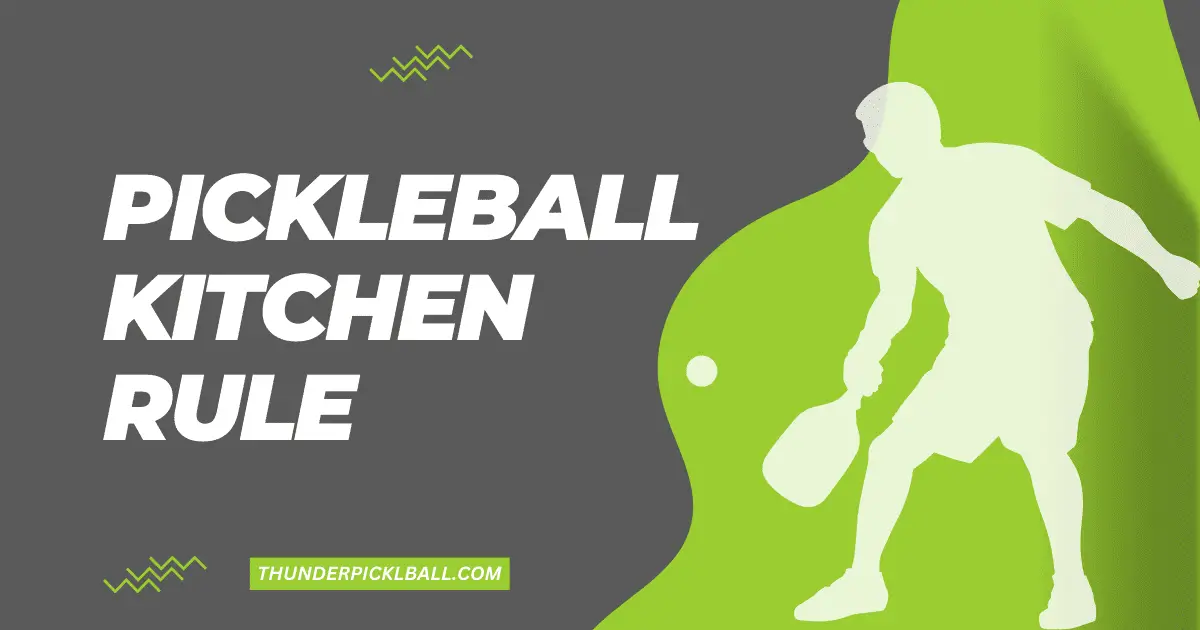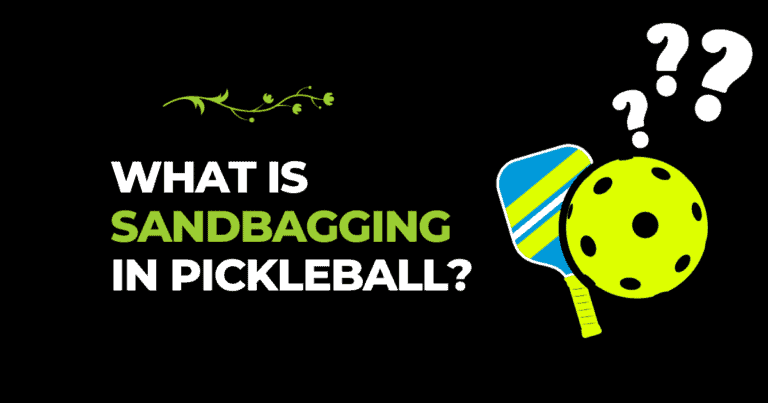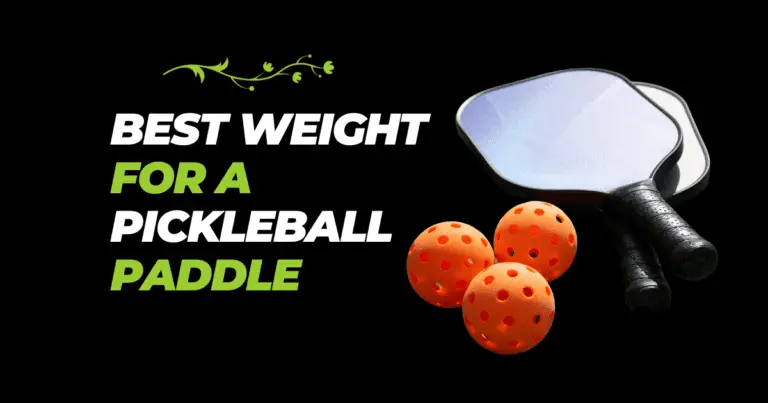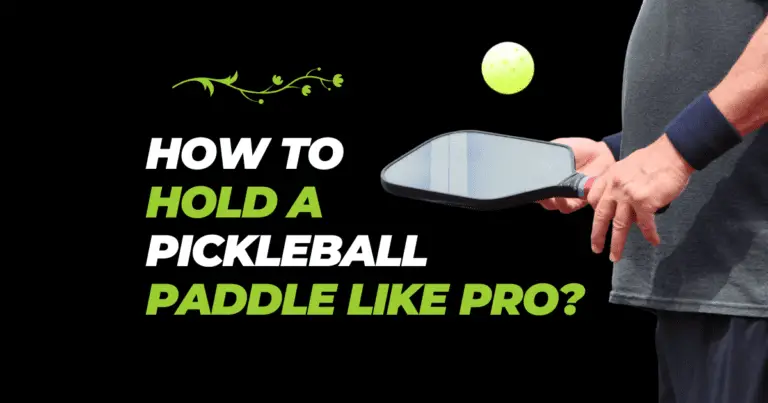Get ready to serve up some fun in the kitchen with the ultimate Pickleball Kitchen Rule!
Whether you’re a beginner or a seasoned pro, it’s crucial to know these essential guidelines to ensure a fair and enjoyable experience on the court. These rules keep the game organized, running smoothly, and on track. So, get ready to hit the court with confidence and discover what makes Pickleball such a thrilling sport.
Whether you’re playing in a local park, a community center, or in your own backyard, these kitchen rules are important. So, without further ado, let’s dive into the world of pickleball kitchen rules.
What is the pickleball kitchen rule?
According to the rule, the kitchen is a flat area on the court, and the rule only kicks in when a ball has been volleyed. The challenge? You must keep your feet outside the non-volley zone, aka the kitchen while volleying the ball. One wrong step and you’ll need to make sure that the ball bounces, or risk breaking the rule.
Did you know that the term “kitchen” might have been inspired by the game of shuffleboard? In shuffleboard, landing in the equivalent 10-off area results in a loss of ten points. So, gear up and get ready to show your skills on the court!
The Purpose of Pickleball Kitchen Rule
Ah, the kitchen rule! It’s the line in the sand, the ultimate divide between domination and defeat in the world of pickleball. It’s the one rule that ensures a level playing field, making every match a battle of wits, agility, and finesse.
You see, the kitchen rule is put in place to stop players from getting too cozy near the net. If you step into the kitchen, you’re restricted from making volleys, which means your offensive abilities are limited, and you’ll have to rely more heavily on your defense. This makes the game more strategic, forcing players to think critically about their next move and choose their shots wisely.
But don’t be discouraged! The kitchen rule also creates opportunities for players to showcase their versatility. By being forced to move around the court, players are encouraged to use a variety of shots and bring their A-game. It’s what makes the game dynamic and challenging, pushing players to their limits and beyond.
So, embrace the kitchen rule, and let’s see what you’re made of! Who knows, this rule may be the key to your pickleball glory!
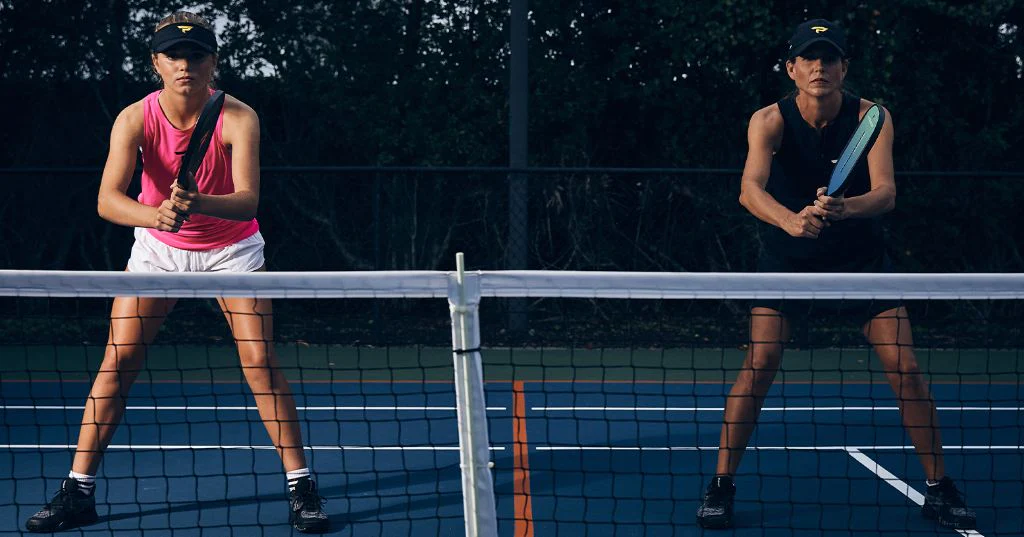
Key Points to Remember about Pickleball Kitchen Rule
- The kitchen is the heart of the Pickleball court, marked by a line on both sides of the net, 7 feet from the net. Think of it as the “no-fly zone” of the court.
- No jumping, no smashing! The kitchen is a no-volley zone, meaning that the ball must touch the ground before you can send it flying back over the net.
- Breaking the kitchen rule will cost you the point. So make sure to keep your feet on the ground and let the ball bounce first. Think of it like a red light, if you jump, you’ll get caught!
- Serving with style! The server must start from behind the baseline and clear the non-volley zone (kitchen) before landing on the opponent’s side of the court. For easy understanding, Picture a pilot who must take off from the runway and reach a certain altitude before flying over the city.
- The kitchen rule is only in effect during the serve and after the return of the serve, so feel free to move through the kitchen as you, please. If the ball is hit back and forth over the net outside of the kitchen, you can move freely around the court.
- Brush up on your kitchen skills! Familiarize yourself with the kitchen rule and abide by it at all times to avoid any unwanted surprises during the game. if you’re not sure about a specific kitchen rule, ask a more experienced player or a Pickleball referee for clarification.
- So remember, keep your feet on the ground and let the ball do the work in the kitchen. Happy Pickleballing! Focus on playing Just like a chef who stays focused in the kitchen and lets the ingredients work their magic to create a delicious meal.
The Pickleball Kitchen Rules Explained
Rule 9.A States That:
One of the key rules is Rule 9.A, which states that volleys must always be played outside of the non-volley zone (NVZ).
When playing Pickleball, it’s essential to understand the NVZ rule, as it helps prevent dangerous situations and ensures that every player has an equal chance of success.
For Example, while playing, if I make the mistake of volleying within the NVZ, I know that a point will be awarded to my opponent, which is a good reminder for me to always stay outside of the NVZ while volleying.
By understanding and following the Pickleball Kitchen Rules, I played with confidence and ensure that each match is fun and enjoyable for everyone involved.
Rule 9. B States That:
In simpler terms, “No touchy, no faulty!” If you touch any part of your opponent’s side of the court during a volley, it’s a fault. That’s right, whether you’re playing singles or doubles, it’s important to keep your racquet and body parts away from the non-volley zone. So, let’s make sure to keep those volleys clean and avoid any costly faults. Remember, the secret to a winning point is a fault-free volley!
Rule 9. C States That:
This rule states that if your momentum carries you into the non-volley zone and you touch anything, including balls, clothing, or your opponent’s belongings, it’s a fault. No exceptions, no excuses.
It doesn’t matter if it was intentional or accidental, you still have to abide by this rule for fair play and safety on the court. So, keep your momentum in check and stay away from the non-volley zone to avoid committing a fault.
Rule 9.D States That:
Rule 9.D – the one that restricts players from volleying if their feet touch the non-volley zone. This rule ensures that players can’t take advantage of their proximity to the net and must instead land outside the zone before hitting back overhand shots. It keeps the game fair and exciting, and I always enjoy the thrill of landing just outside the zone to set up my next shot.
Pickleball Court and Non-Volley Zone
A Pickleball court is a rectangular area measuring 20 x 44 feet, and it is divided into two equal halves by a net that is hung at a height of 36 inches at the center. The non-volley zone, also known as the kitchen, is a 7-foot area on each side of the net where players are not allowed to make a volley.
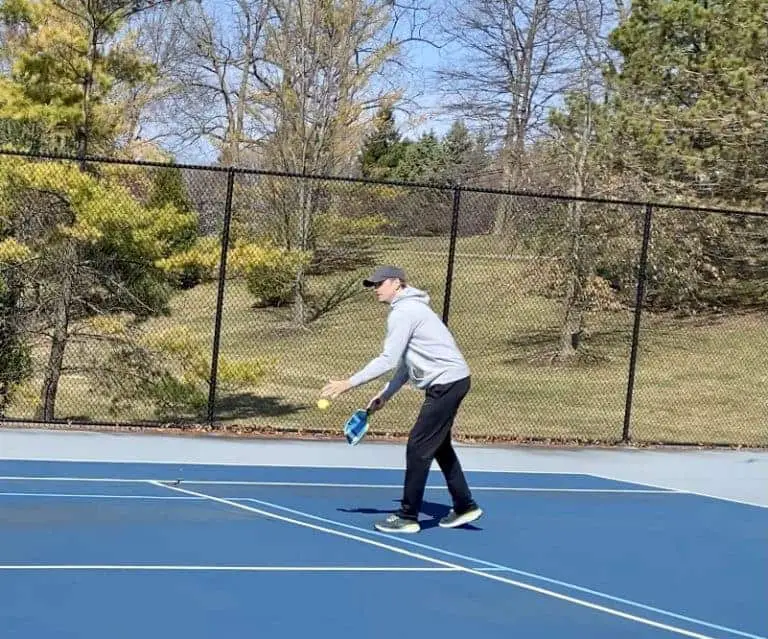
FAQs Pickleball Kitchen Rule
Can you step into the kitchen before it bounces?
No, according to the rules of pickleball, players are not allowed to step into the kitchen (the non-volley zone) before the ball bounces. If a player steps into the kitchen before the ball bounces and then hits a volley, it is considered a fault.
Can your foot touch the kitchen line in pickleball?
No, your foot cannot touch the kitchen line in pickleball. The kitchen line serves as the non-volley zone and players are not allowed to volley if their feet are in the kitchen. They must land outside of the kitchen before hitting back overhand shots. This rule adds a strategic element to the game and helps keep it fair.
Are you allowed in the kitchen for pickleball?
Players are not allowed to volley in the kitchen, and must instead hit their shots from outside of the non-volley zone.
Can a player step into the kitchen while volleying the ball?
No, a player cannot step into the kitchen while volleying the ball. And don’t even think about trying to hit a volley with just one foot touching the kitchen line. That’s a big no-no in pickleball.
The non-volley zone is strictly off-limits for volleying, so make sure both feet are outside the line before making any overhand shots. Trust me, you don’t want to get called out for breaking this rule. Stick to the rules and let’s have a fair and exciting game!
Can you jump and land in the kitchen in pickleball?
No, jumping and landing in the kitchen in pickleball is not allowed. If a player lands in the kitchen while attempting a shot, it is considered a fault and their opponent scores a point.
When will I be able to hit a volley once again if I’m in the kitchen?
You will be able to hit a volley once again if you move outside the non-volley zone (kitchen) and both feet are completely outside the zone before making contact with the ball.
What if a player executes the volley, but his cap falls into the Kitchen?
If a player executes a volley, but his cap falls into the kitchen, it is considered a fault and the point will go to the opposing team. This is because the kitchen is considered out of bounds, and anything that enters the kitchen is considered a fault. The player must retrieve the cap and continue play, but the point will not be replayed.
Is it possible to play pickleball in the kitchen?
Yes, you can play pickleball in the kitchen, but with some restrictions. You are only allowed in the kitchen while serving, returning a serve, or playing a groundstroke. Stepping into the kitchen during a volley is a fault unless the ball lands in the kitchen first. So, be sure to stay outside the kitchen during play to avoid any penalties!
What Happens If You Violate the Pickleball Kitchen Rule?
If you violate the Pickleball Kitchen Rule, a fault will be called and the opposing team will be awarded a point. This rule is in place to ensure fair play and player safety, so it’s important to be aware of the non-volley zone (NVZ) and make sure that volleys are always played outside of it.
If you accidentally step into the NVZ while playing, it’s important to immediately step back out to avoid violating the Pickleball Kitchen Rule and potentially giving up a point to your opponent.
Why is it called the kitchen in pickleball?
The non-volley zone (NVZ) in Pickleball is commonly referred to as the “kitchen” due to its location at the back of the court, near the net.
The term “kitchen” was likely coined because volleys are not allowed in this area, similar to how you wouldn’t be allowed to cook or prepare food in someone else’s kitchen. The kitchen rule helps ensure player safety and fairness in the game, as volleys made too close to the net can create dangerous situations and provide an unfair advantage over opponents.
What Is The Kitchen Area in Pickleball?
The kitchen in Pickleball is the non-volley zone (NVZ), 7 feet from the net on both sides of the court. Marked by a line, it limits volleying to ensure player safety and fair play. Players can be in the kitchen for serving, returning a serve, or playing a ground stroke but not for volleying.
Have you ever had a powerful volley that carried you right into the kitchen, even after the ball had bounced twice on your opponent’s side?
Unfortunately, that’s a big no-no in Pickleball! Once you’ve made a volley, your momentum cannot carry you into the kitchen, even after the ball is considered dead.
So, no matter how intense the game gets, make sure to stay out of the kitchen zone to keep the game fair and safe for everyone involved.
Can your partner save you from a kitchen violation while volleying?
Yes! Your partner can hold you back to prevent you from entering the non-volley zone as long as they are not in the NVZ themselves. So, go ahead and make those fantastic volleys with confidence!
Can I hit a shot that bounces first while I am standing in the Kitchen?
Yes, you can hit a shot that bounces first while you are standing in the kitchen However, it is important to note that you cannot volley the ball while standing in the kitchen.
The kitchen rule applies to volleys only and allows players to enter the kitchen for serving, returning a serve, or playing a groundstroke.
Summary
The Kitchen Rule: A Simple Yet Vital Regulation in the Game
Do you know the importance of staying out of the Kitchen during play?
Let’s break it down into 3 key points:
- Stay out of the kitchen, unless the ball lands there first.
- Touching the Kitchen, even just with a body part, is a fault.
- Swing, follow-through, momentum? Keep them away from the Kitchen line!
Remember these rules to stay in the game and avoid penalties!
Images credit goes to thevolleyllama.com & paddletek.com

